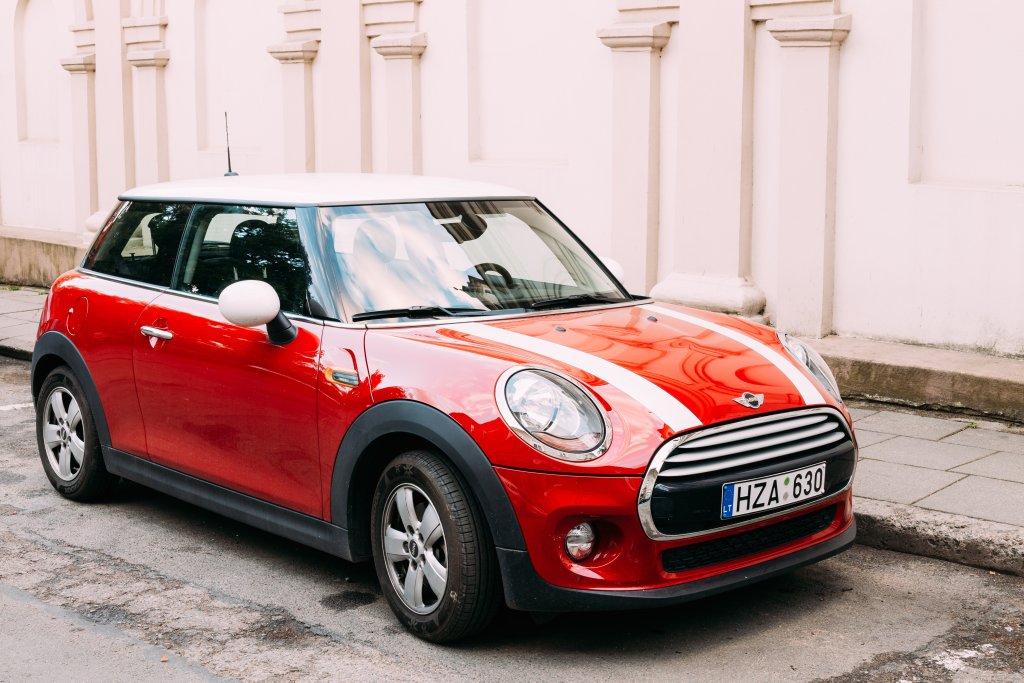Extremes tend to attract attention in the automobile world. Jumbo vehicles like the original Hummer turned heads due to their bulk and brawn. On the opposite end of the spectrum are tiny cars like the Mini Cooper. While the first Mini started in 1960s Britain, it never reached the U.S. in large quantities due to its diminutive size.
The Mini’s fortune changed following the brand’s acquisition by BMW in 1996. Seeking to expand its product portfolio, the German automaker went to work reinventing the iconic Mini Cooper. This was when vintage was cool for car buyers and manufacturers. Volkswagen hit a home run with the reintroduction of the storied Bug (New Beetle) in 1998, and even Chrysler joined the fray with the retro-inspired PT Cruiser, which launched in 2001.
BMW climbed aboard by introducing an all-new Mini Cooper in time for the 21st century. Knowing that the American market was crucial to the car’s success, BMW had envisioned a larger Mini early on. This newest iteration was 20% larger than its predecessor, making it more suitable for U.S. consumers. The first examples hit American shores for the 2002 model year.
Although I grew up around V8s and Detroit steel, I’ve always appreciated how other countries tackled automotive design and engineering. My initial reaction to BMW’s Mini was like most people’s: a mix of “Isn’t that cute!” and “Is there room inside?”
But the Mini Cooper is hard to understand until you spend time behind the wheel. It’s undoubtedly no stoplight racer, but the Mini’s combination of zippy acceleration and precise handling can be addictive. BMW’s DNA is evident (later Mini Coopers share a platform with the BMW X1).
For many, the Mini Cooper is an ideal blend of efficiency and upscale. Car buyers wanting something besides a Honda Civic or Toyota Corolla can turn to the Mini Cooper, knowing they’re setting their own path. The company’s customization options (like a Union Jack on the roof or side mirrors) offered other opportunities to drive something a bit different.
At the same time, new Mini Coopers aren’t cheap; prices start at $26,000, about 15% more than a Corolla. This premium means Mini fans turn to second-hand examples as a more affordable approach.
Notably, not every Mini Cooper model year is a slam-dunk buy. Some examples have documented dependability issues or safety concerns.
Reviewing engine reliability data from Mini Coopers with installed FIXD sensors offers a starting point for identifying the best and worst years. What I found particularly surprising is that the oldest Minis aren’t the worst offenders. There are recent examples that should be avoided instead.
The FIXD Reliability Score (a measurement of engine reliability from FIXD sensors) is a key determiner in my Mini Cooper model year analysis. Yet, I considered other vital factors, including safety, fuel economy, maintenance costs, and market value. F.I.R.I.S. (FIXD Internet Review Index Score) also affected these outcomes. F.I.R.I.S. is a summary score of owner and professional reviewer feedback.
I’ll also clarify that this assessment is for the Mini Cooper Hardtop 2 Door. We’ll save a look at the Countryman, Clubman, Convertible, and Hardtop 4 Door for other articles.
Keep reading for the detailed analysis, but here’s an overview of the best and worst years of the Mini Cooper from 2002-2020.
Mini Cooper Engine Reliability Score, Safety Ratings, MPG, Value v.s. Value for the Money, and F.I.R.I.S. – Year by Year
The findings for the best and worst Mini Cooper years are based on:
- FIXD Reliability Scores (engine reliability)
- National Highway Transportation Safety Administration (NHTSA) safety ratings
- Environmental Protection Agency (EPA) fuel economy estimates
- Kelley Blue Book (KBB) market value compared to yearly upkeep costs (based on RepairPal.com data).
- F.I.R.I.S. rankings (a summary of online ratings and reviews):
While all these elements contribute to the rankings, engine reliability tops the list. I think most car owners would agree that without a dependable powerplant, a car doesn’t have much value. That’s why I place greater emphasis on this factor than all others in determining the best and worst years of the Mini Cooper.
FIXD sensor data provides a definitive tool for measuring engine reliability. Yet, this determination isn’t a simple “yes” or “no” but rather a question of severity. It’s not uncommon to see more engine problems with older vehicles, so a car that’s not so old and with problems under the hood is a major red flag.
The FIXD Reliability Score ranges from 1 (poor) to 10 (perfect), with 5 being average. Usually, I’ll set 3 as the bare minimum score for a vehicle to be considered for the best years list. Yet, a review of FIXD Reliability Scores for the Mini Cooper revealed a surprise: very few model years had low scores. Only 3 out of the 19 years assessed had a 3 or lower FIXD Reliability Score. This is a good thing overall for Mini Cooper buyers, but it raises the standards.
As a result, a Mini Cooper needs at least a FIXD Reliability Score of 5 to get a thumbs up. I’ll expand on these scores below.
Besides engine reliability, I also consider other Mini Cooper qualities before passing judgment. In the case of this Mini and its modest size, safety is an essential factor. As you’ll learn later, NHTSA cited two model years for a particularly troubling safety concern. With some other editions, I also weigh fuel economy, upkeep costs, and resale value to make a final decision.
I’m also very skeptical of recommending the first year of a new model or generation. Research reveals that brand-new vehicles tend to be headaches for their owners. And the Mini Cooper (especially from 2007 and 2014) confirms my suspicions. Staying away from all-new cars means playing the odds in your favor because any initial “gremlins” often get worked out in later model years.
Check out the best and worst years stories about other small cars, like the Toyota Corolla, Honda Civic, and Chevrolet Cruze.
If you’re in the market for a car, take a look at our article on the USA’s most reliable and cheapest to repair cars in the U.S. Don’t get stuck with a lemon; use our data to help you shop.
Engine Reliability Score – Over The Years
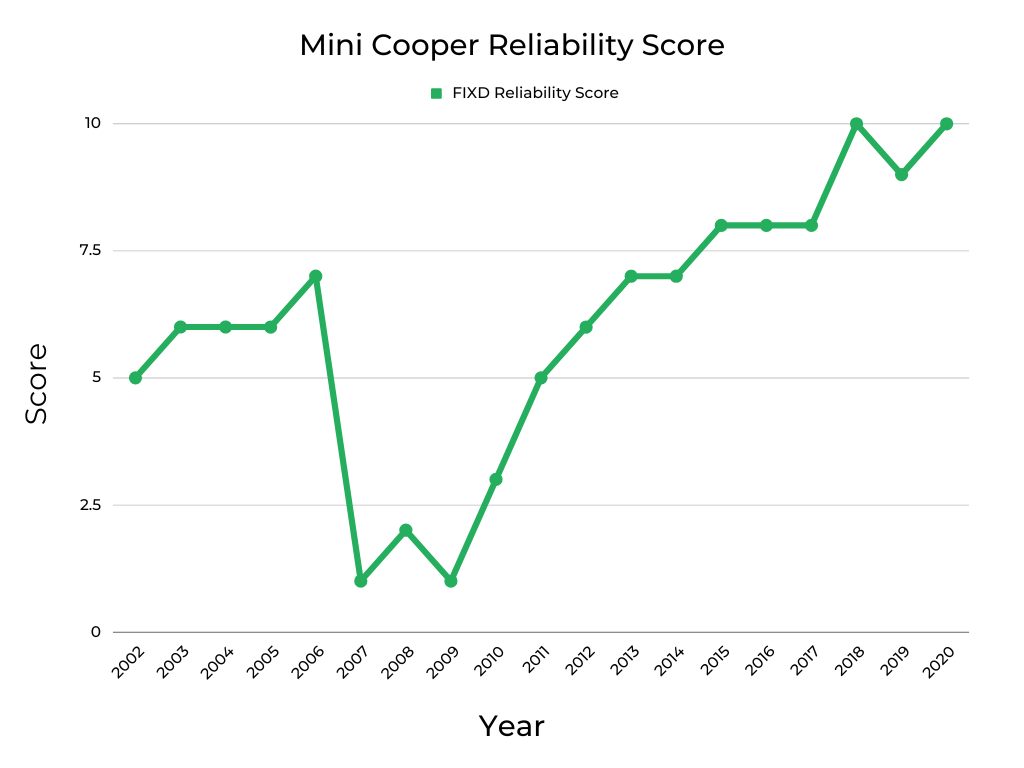
FIXD sensors capture check engine light frequency in the Mini Cooper. As mentioned, 10 represents the best FIXD Reliability Score, and 1 is the lowest (meaning the greatest number of dashboard error warnings). So, it’s evident that the 2007-2010 editions are the bottom of the barrel. It’s a shame because these model years spoil otherwise decent overall engine reliability history.
What’s especially remarkable is that the oldest Mini Coopers don’t represent the lowest scores. This isn’t usually the situation, and it makes a compelling case for buying an older Mini (I’ll explain later). In particular, seeing an above-average FIXD Reliability Score of 7 for a 2006 edition is especially appealing. Even decade-old examples (2013 and 2014) have the same ranking.
I’ll also point out that not every check engine light translates into an expensive repair bill. Sometimes, all it takes is a damaged or loose gas cap to trigger a warning. A failing battery or disconnected hose can do the same thing.
NHTSA Safety Score – Over The Years
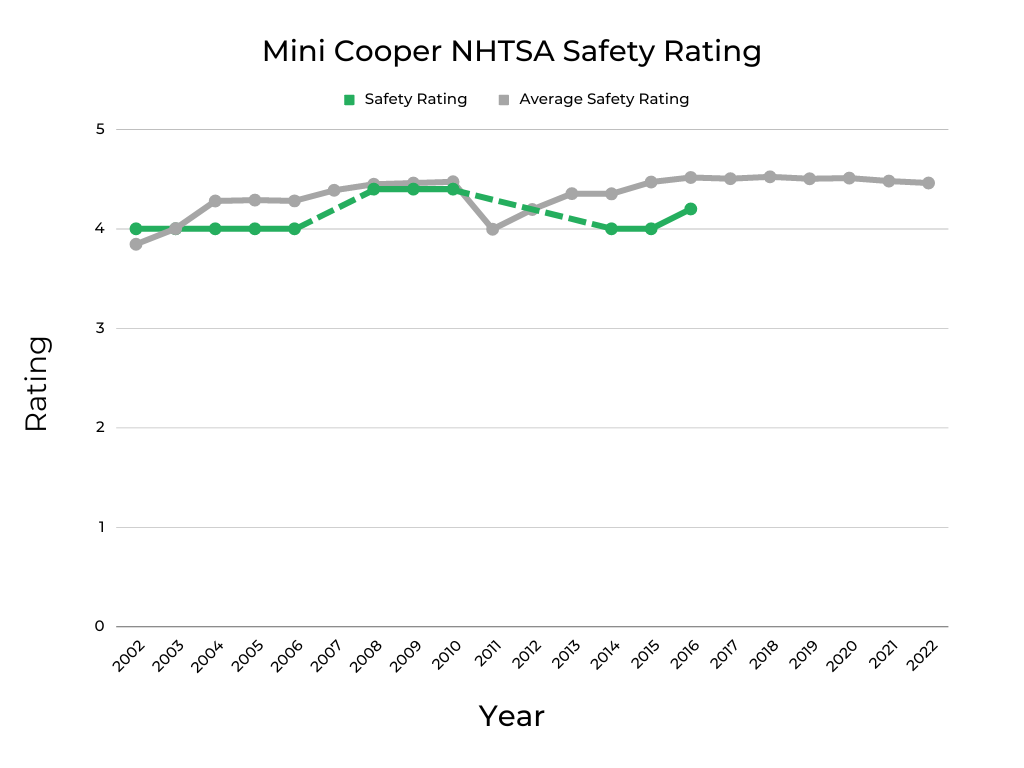
While safety may be an afterthought for most car buyers, those shopping for smaller vehicles are well advised to review government crash tests. The Mini Cooper is one of the smallest automobiles on the road, so every bit of protection can help. To me, that means a vehicle that scores at least a 4.0 (out of 5)—something that the Mini Cooper does for every year it’s assessed.
There are some gaps (2007, 2011-2013, and 2017-2020), which isn’t unusual. Although the actual reasons for this lack of testing are unknown, I can surmise the explanations.
2007 marked the debut of the second-generation Mini Cooper, and a production model may not have been ready for review. Meanwhile, 2011 marked the introduction of more stringent testing, and Mini decided to hold off on NHTSA testing until the third generation launched for 2014. Your guess is as good as mine about no testing after 2016. Perhaps Mini felt NHTSA assessments were unnecessary due to no substantial changes to the Mini Cooper.
However, there’s more to NHTSA testing than numbers. Despite solid 4.0 scores, the 2014 and 2015 model years get a thumbs down from me due to structural issues that can increase the risk of serious injury. This is explained further below in the worst years section.
Did you know that buying a safer vehicle helps keep insurance rates low?
If you live in one of the states listed below, we can show you the cheapest vehicles to insure in yours.
| What Used Cars Are the Cheapest To Insure In: |
| Ohio |
| North Carolina |
| Michigan |
| Georgia |
| Texas |
| New York |
| Illinois |
| Pennsylvania |
| California |
MPG – Over The Years
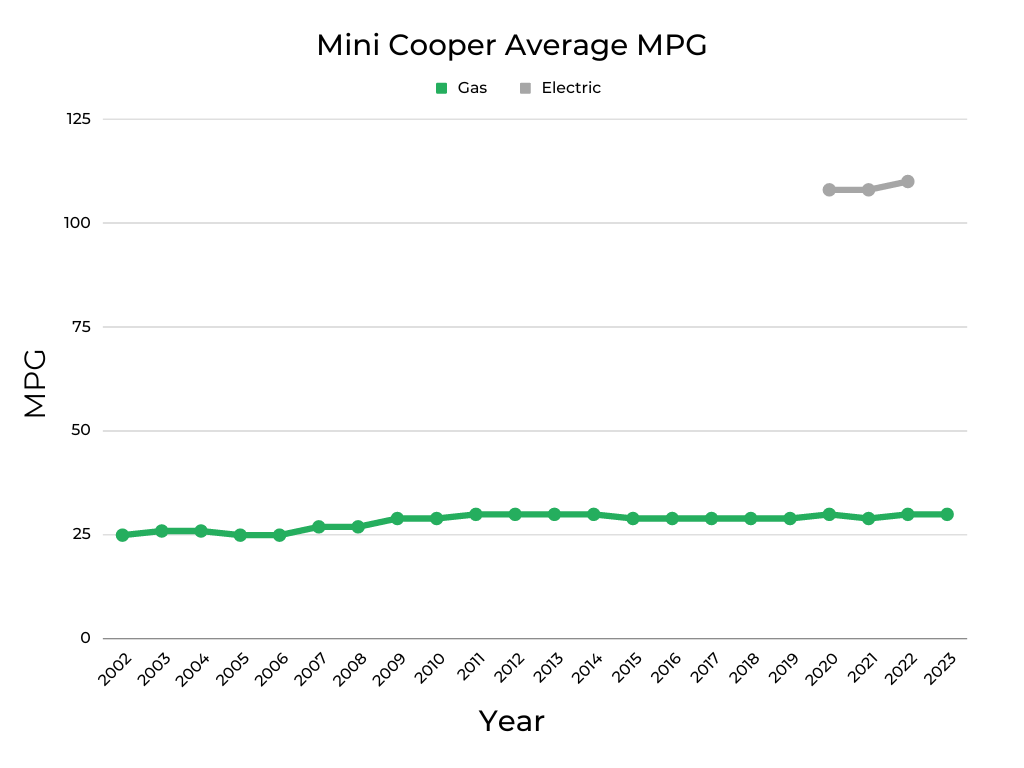
One advantage to the Mini Cooper’s size is respectable fuel economy—at least 25 MPG, with newer editions reaching 29-30 MPG. Admittedly, these are not hybrid numbers (40+ MPG), but Mini did not engineer this car to be a complete fuel sipper. The Mini Cooper’s “zippyness” has to come from somewhere. The somewhat performance-oriented Cooper S and John Cooper Works variants will also have an MPG penalty.
This balanced approach to fuel economy is the secret to the vehicle’s success and cult-like following. Mini is just as concerned with smiles per mile as miles per gallon.
Mini launched the all-electric Cooper SE in 2020, but its modest range (about 110 miles) left EV buyers underwhelmed. On the other hand, its $31,000 price tag (when new) makes it one of the most affordable EVs on the road.
Current Market Value of All Mini Cooper Years vs. Value for the Money
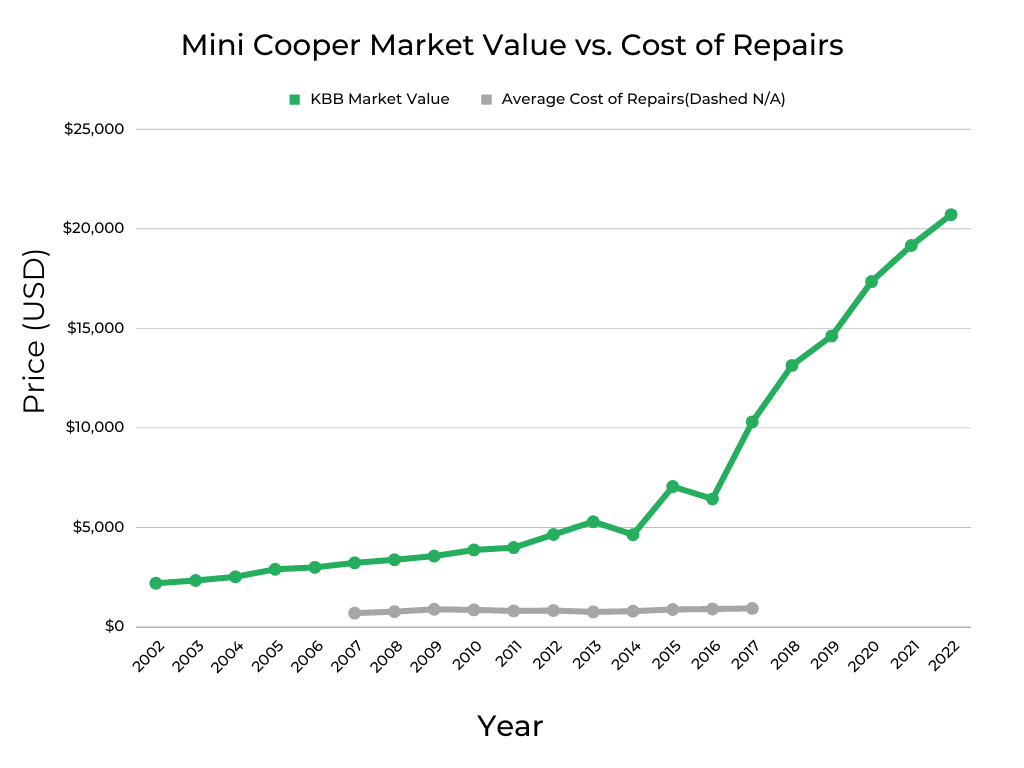
Market values for most cars work one way: the newer it is, the higher it’s worth. This is what we see with the Mini Cooper’s market value (green) according to Kelley Blue Book (KBB). There’s an unexplained dip for 2014, but the drop in value for 2017 can be reasoned by higher maintenance and repair costs (gray). Increased upkeep expenses can drag down a car’s value.
This brings up the unpleasant side of Mini Cooper ownership: above-average costs for keeping this compact cruiser on the road. Based on the available RepairPal data, the typical Mini Cooper owner spends $846 annually for repairs and maintenance. In comparison, the same expenses for a Toyota Corolla run $362.
The worst offender for upkeep costs is the 2017 model, with usual yearly outlays adding up to $956. The 2016 Mini Cooper is a close second place at $925. Even the cheapest-to-own model year (2007) costs twice as much ($717) as the average Corolla. Mini Cooper ownership comes at a price.
When shopping for a used (make) (model), it’s important to keep in mind that not all vehicles are cared for equally. To protect yourself from lemons, take along a FIXD Sensor on your test drive. FIXD connects to a free app on your smartphone to tell you more about the vehicle you’re checking out, including check engine lights and other hidden issues that the owner or dealership may be attempting to hide. Click here to learn more and get FIXD for only $19.99 (regular price $59)!
F.I.R.I.S. – FIXD Internet Review Index Score– Over the Model Years
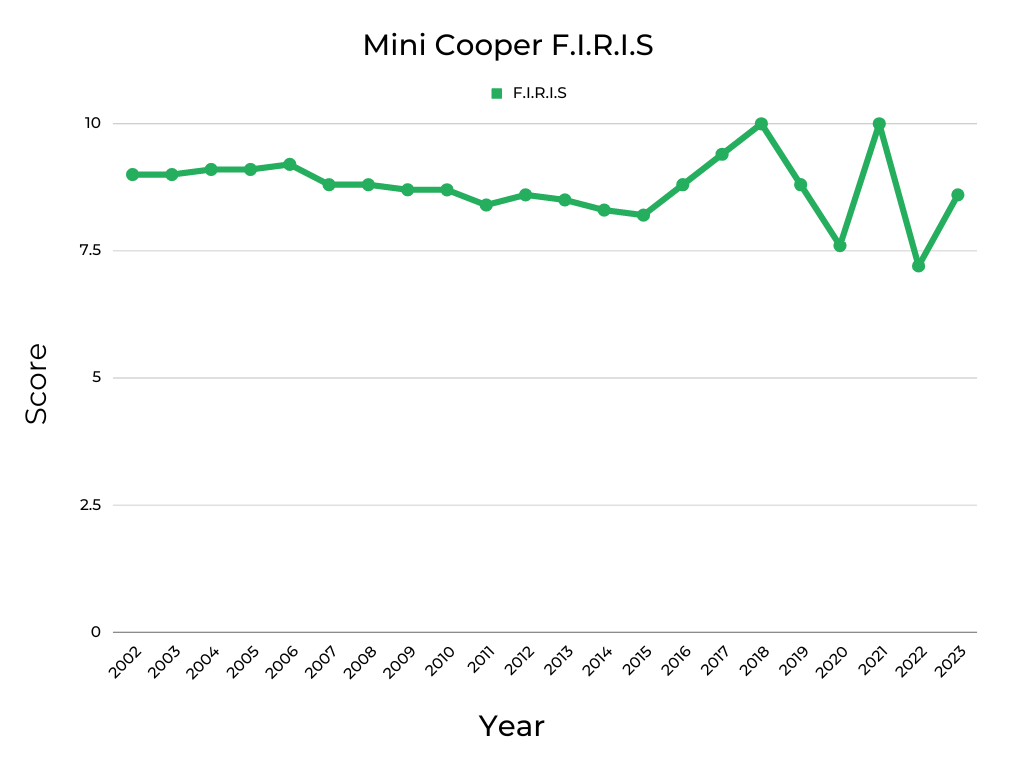
F.I.R.I.S. sounds more complicated than it is. We compile year-specific model ratings from four trusted automotive sites: Cars.com, Edmunds, KBB, and CarGurus. These scores are then averaged and recalculated on a scale of 1-10. Centralizing this information brings together varying viewpoints in an easy-to-understand format.
Based on F.I.R.I.S. stats, owners and professional reviews have a love/less-love (I wouldn’t call it hate) relationship with the Mini Cooper. Ratings for the earliest model years (2002-2007) soar to 9.0 or higher (out of 10).
But, the rankings drop below this plateau starting with the 2008 model year. The F.I.R.I.S. never reached “A-” territory until the 2017 edition, and it’s impressive 9.4. In truth, scores of 8.2-8.8 aren’t terrible (far from it), so don’t disregard these model years (at least the ones that make the best years list).
Interestingly, the lowest F.I.R.I.S. (7.6) comes from the 2020 model year—the same edition that received a perfect 10 out of 10 for engine reliability. This is due to rankings only from CarGurus, which didn’t think too highly of this Mini.
Keep in mind that F.I.R.I.S. ratings are primarily subjective. While professional reviewers often use standardized scales to rate vehicles, there’s still some opinion involved in assigning ratings. And, of course, owners are likely biased (people tend to like their cars). So, F.I.R.I.S. is helpful, but only to a point. Purchase decisions must also reflect the other factors we covered (engine reliability, safety, fuel economy, upkeep, and market value).
Important Features Timeline
2002: Debut of the Mini Cooper in the U.S.
2003: Audio system is now satellite radio-ready
2004: A digital speedometer is added to the instrument cluster
2005: More engine output for the Cooper S; manual transmissions get shorter throw configurations
2006: The optional Checkmate package adds traction control, HID lamps, and other goodies
2007: The second-generation Mini Cooper is launched
2008: No major changes; automatic up/down windows are added
2009: Stability control is added across the range
2010: All trims get a multi-function steering wheel and cruise control
2011: All versions get a slight horsepower bump and a reworked audio system
2012: No major changes; floor mats are standard
2013: All Mini Coopers get Bluetooth
2014: Launch of the third-generation Mini Cooper
2015: Automatic climate control and heated mirrors are added to the standard equipment list
2016: No major changes
2017: Tech goodies like a larger touchscreen and smartphone integration are standard.
2018: Rear parking sensors and a rearview monitor are standard
2019: Infotainment system is upgraded with an easier interface
2020: All transmissions are reworked
The Best Years of the Mini Cooper
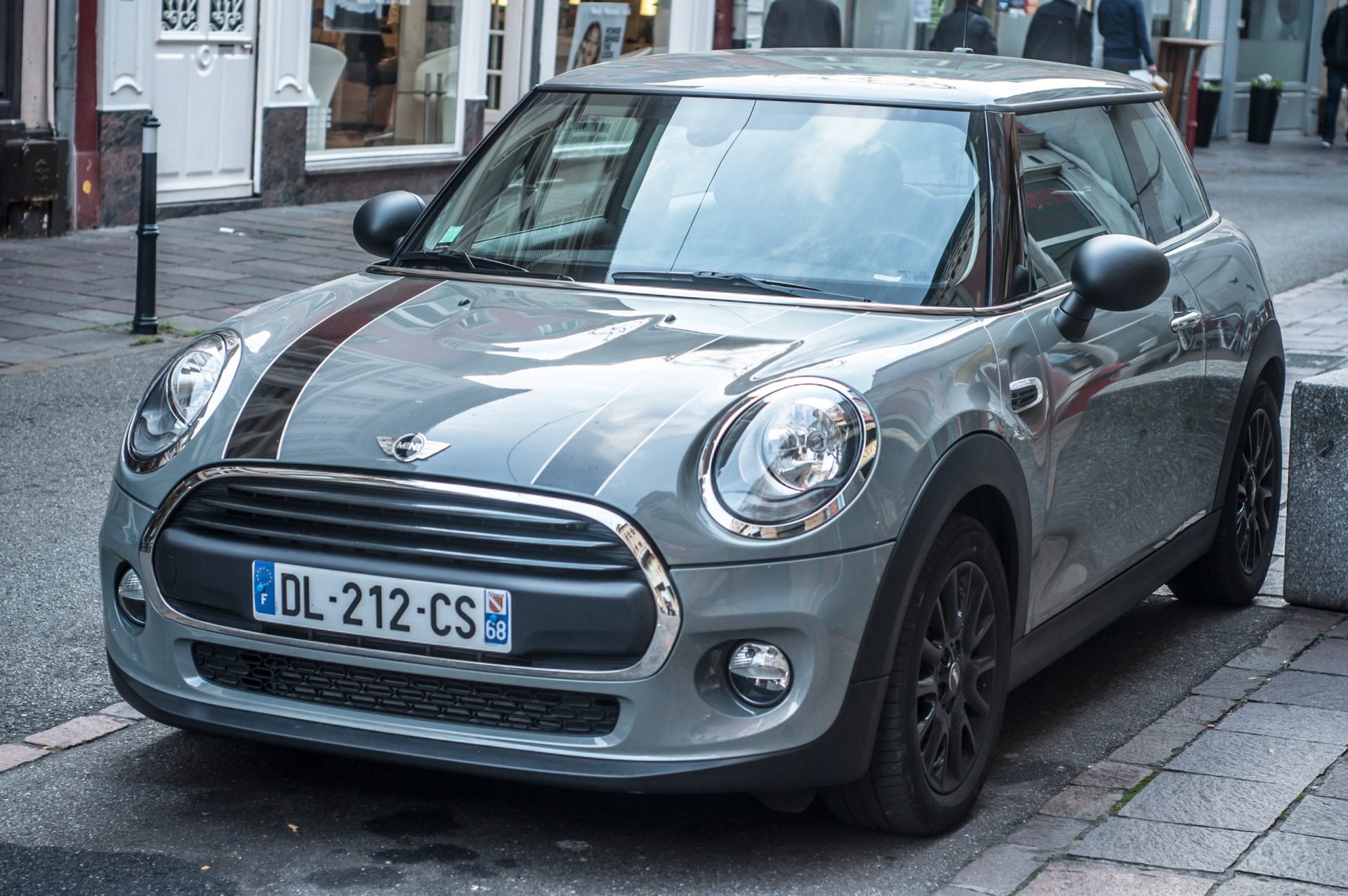
With more than two decades of model years, many options exist for buying a used Mini Cooper. This cream of the crop is based mainly on an analysis of FIXD Reliability Scores and crash test results. In addition, fuel economy, maintenance costs, market value, and F.I.R.I.S. ratings play a role in the decision process. Further, I’ve included details about the most common diagnostic trouble codes (DTCs) according to FIXD sensor data. Identifying likely problems in advance can prepare you for Mini Cooper ownership and guide a mechanic during a pre-purchase inspection.
2016-2020 Mini Cooper

FIXD Reliability Score: 8-10/10
FIXD Internet Review Index Score (F.I.R.I.S.): 7.6-10/10
KBB Value: $6,446-$17,351
Fuel Economy: 29-30 mpg
RepairPal Average Annual Repairs Total: $925-$956 (2016-2017)
Safety Rating: 4.2/5 (2016)
There’s no mystery why the 2016-2020 model years top the best years list. This placement is mainly due to stellar engine reliability. The 2018 and 2020 editions received a flawless 10 out of 10, followed by the 2019 Mini Cooper with an impressive 9. Even the 2016 and 2017 scored a solid 8, and these less-recent cars aren’t too far off from being a decade old.
The 2016 Mini Cooper received a 4.2 (out of 5) in government crash testing, making it among the best-forming examples in NHTSA assessments for this model. Later models weren’t tested, but there’s every reason to believe newer Mini Coopers will perform similarly (the car hasn’t changed substantially since 2016).
At the same time, an average fuel economy of 29-30 MPG means fill-ups will be few and far between (although the 10.6-gallon fuel tank is modest).
As mentioned, the F.I.R.I.S. for the 2016 edition is out of whack because of minimal review data. Otherwise, this group of Mini Coopers is well-regarded, especially the 2018 model year (it received a F.I.R.I.S. of 10).
Regarding recalls, the 2016 Mini Cooper is subject to four official notices. Yet, these involve non-critical systems (yes, problems with seat belts and airbags are vital, but they don’t impact reliability). There are zero recalls for the 2017-2020 model years.
Yet, no car is perfect. The 2016 and 2017 editions have their share of check engine lights (yet not at the alarming levels of some older Mini Coopers, which is covered later). FIXD sensor data shows that P0456, a leak in the evaporative (EVAP) emission control system, is the most common problem. As repairs go, it’s not too bad. Tightening or replacing the gas cap ($20-$60) or installing a new EVAP line ($50-$100) often resolves the trouble. Sometimes, swapping out a control valve ($150-$200) or the charcoal canister ($200-$600) is necessary.
Another frequent DTC is code P0171, a lean fuel mixture (too much air or insufficient fuel). Fixes usually require cleaning the mass air flow (MAF) sensor ($100) or correcting a vacuum or exhaust leak ($100-$200). Some situations may involve replacing the oxygen sensor ($200-$300), MAF sensor ($300), fuel pressure regulator ($200-$400), or fuel pump ($1,300-$1,700).
There are error codes for these problems with the 2018-2020 Mini Coopers but at a substantially lower level.
Dealer prices for a Mini Cooper in this group will range from $12,000 to $36,000, depending on age, condition, mileage, and equipment. The referenced KBB values are for private-party sales, usually less than retail prices.
Mini offers a certified pre-owned (CPO) program for models that are less than five years old and with under 60,000 miles. You’ll pay a premium for this coverage, but you’ll get one year (with no mileage limits) added to any existing factory warranty.
If a CPO warranty isn’t your thing, I’d suggest looking at a 2018 Mini Cooper. The data shows perfect FIXD Reliability and F.I.R.I.S. ratings, no recalls, and few DTCs. Careful shopping should uncover examples for under $20,000.
It wasn’t too long ago that newer second-hand Mini Coopers were cheap, but craziness in the used car market has pushed prices higher (especially for cars below $20,000).
2011-2013 Mini Cooper
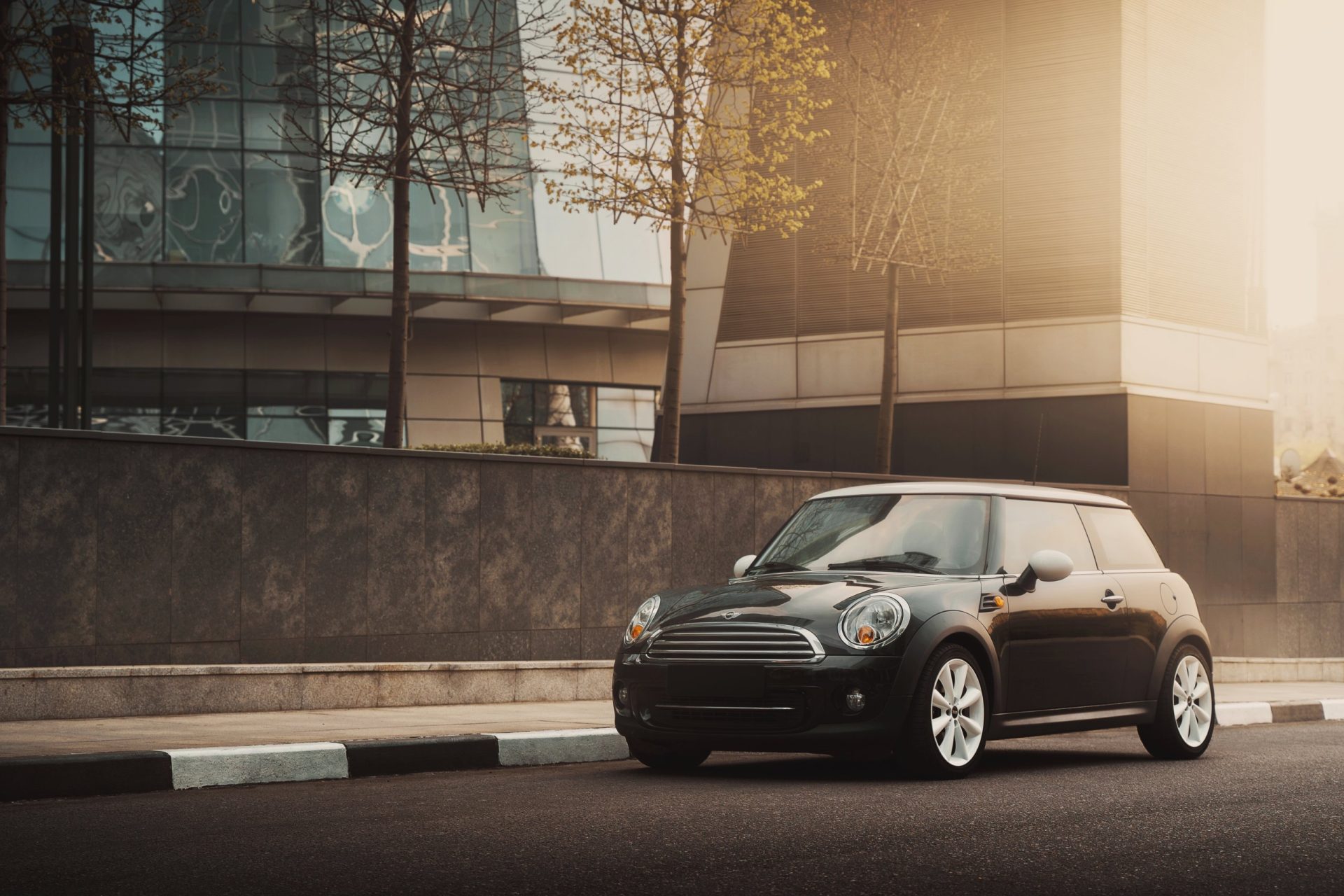
FIXD Reliability Score: 5-7/10
FIXD Internet Review Index Score (F.I.R.I.S.): 8.4-8.6/10
KBB Value: $4,006-$5,304
Fuel Economy: 30 mpg
RepairPal Average Annual Repairs Total: $780-$849
Safety Rating: N/A
If five figures is too much of a wallet stretch, check out the 2011-2013 Mini Cooper. The marketplace is plentiful, with examples selling for $5,000 to $7,000. A $10,000 budget will get you something with under 75,000 miles.
There’s a lot to like about these model years. An average fuel economy rating of 30 MPG will help the dollar go further, and annual repairs are at or below the typical $846 outlay.
Meanwhile, the F.I.R.I.S. gives these Mini Coopers a commendable “B” grade. B students may not get the most attention, but they get the job done. And speaking of grades, the 2011-2013 Mini Cooper gets mid-tier rankings for engine reliability. Scores of 5-7 are nothing to write home about, but these are decade-old (or older) vehicles.
These FIXD Reliability Scores translate into a healthy dose of check engine lights, especially with the 2011 model year. Code P0087 is among the typical culprits. It indicates a problem in the fuel delivery system. Corrections start with replacing the fuel filter ($86-$182) or the fuel line ($125-$500). Pricier repairs can involve a new fuel pump or fuel tank ($900-$2,100).
When a dashboard warning light illuminates in a 2011-2013 Mini Cooper, the problem may likely be code P0300, P0301, P0302, or P0304. These are all error messages for an engine misfire, a potentially serious issue. Fortunate Mini Cooper owners only have to deal with new spark plugs ($66-$250), spark plug wires ($180-$240), or ignition coils ($230-$640). A vacuum leak could also be to blame. Repairs could also require replacing the fuel pump or the fuel injectors ($1,500-$1,900).
Safety for the 2011-2013 Mini Coopers is a bit of a black hole as there’s no NHTSA testing for these years. The 2008-2010 model years received a 4.4 (out of 5) in government evaluations, but the standards became more rigorous starting with the 2011 model year. So, under older testing, the 2011-2013 editions likely did well (probably similar to the 4.4 from the earlier years). However, there’s no information about how this group performed under the updated rules. Plus, 2014 marked the start of the third generation, meaning a look forward isn’t helpful either.
While recalls don’t necessarily define a vehicle’s reputation for dependability, fewer is always better. The 2011, 2012, and 2013 Mini Cooper have one recall each.
2003-2006 Mini Cooper
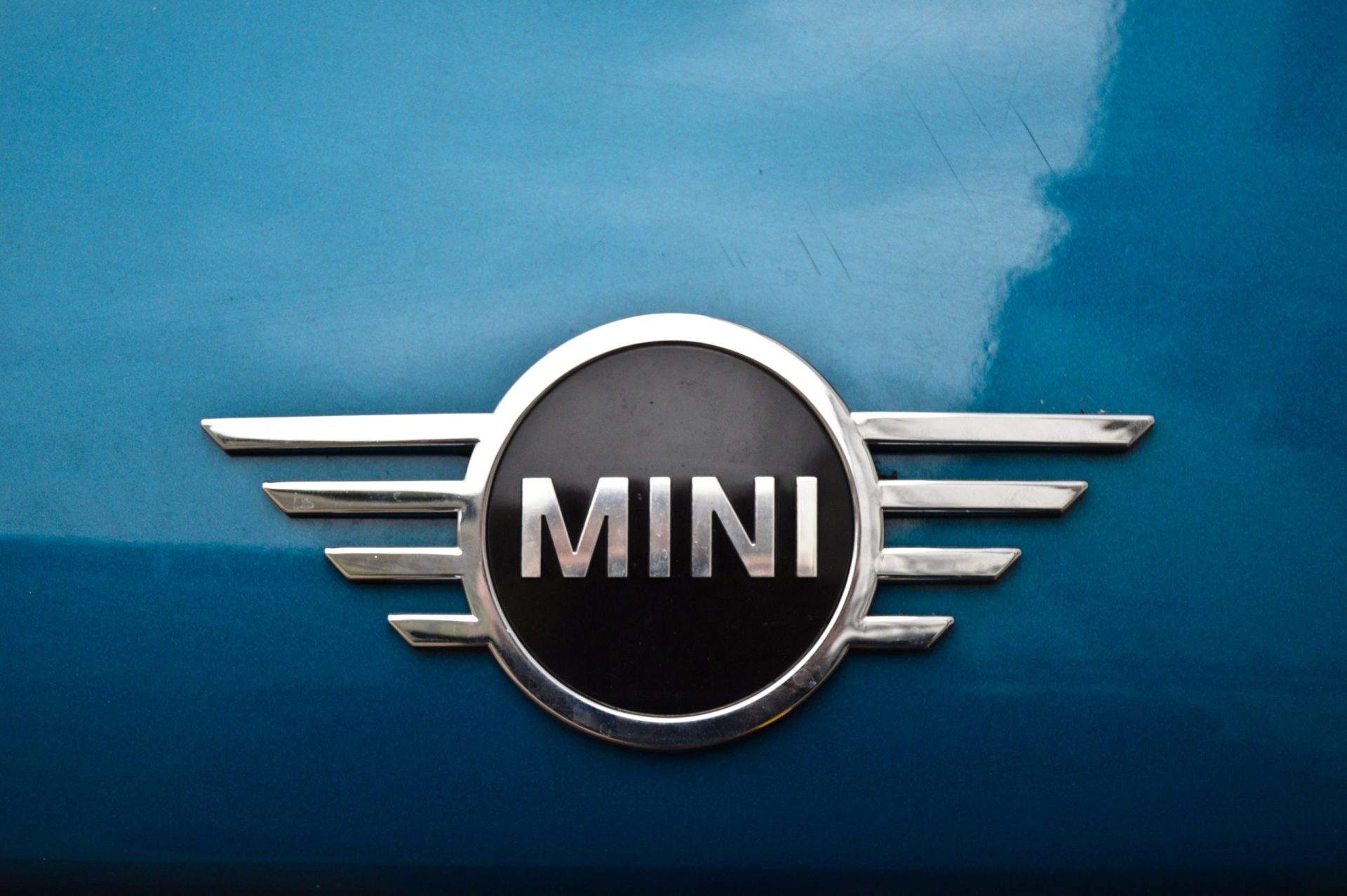
FIXD Reliability Score: 6-7/10
FIXD Internet Review Index Score (F.I.R.I.S.): 9.0-9.2/10
KBB Value: $2,356-$3,015
Fuel Economy: 25-26 mpg
RepairPal Average Annual Repairs Total: N/A
Safety Rating: 4.0/5
Reviewing vehicle reliability data often uncovers surprises. This was certainly the case in looking at the FIXD Reliability Scores for the 2003-2006 Mini Cooper. I expected much lower results than an above-average 6-7. This is particularly encouraging for someone looking to spend $5,000 or less on a Mini Cooper.
In addition, an overall NHTSA safety rating of 4.0 is equally noteworthy, as is a F.I.R.I.S. of at least 9.0. Further, no one will complain about getting 25-26 MPG with a cheap car.
But I need to add some real-world considerations as these are 20-year-old vehicles. There’s no RepairPal data for yearly repair and maintenance costs for the model years. Evidence (moderate FIXD Reliability Scores) suggests that the 2003-2006 Mini Coopers should have similar upkeep expenses (an average of $846 per year).
However, increased vehicle age adds an element of unpredictability to the equation. Major systems like the catalytic converter can fail and be expensive to replace (see the following discussion about error codes).
As with some newer Mini Coopers, code P0456, a leak in the EVAP system, is known to occur among the 2003-2006 model years. Other problems with the emissions control system can include P0420, a faulty catalytic converter. At best, you’ll only need to replace an oxygen sensor or fix an exhaust leak. Yet, replacing the catalytic converter requires spending up to $2,400, which could represent half of the car’s value. Ideally, any 2003-2006 Mini Cooper under consideration will have already received a new catalytic converter.
P0130 is also related to emissions and involves a faulty oxygen sensor. The solution requires replacing the unit or sealing an exhaust or vacuum leak.
There are four recalls each for the 2003, 2004, and 2005 model years, with the most serious involving a defect in the power steering unit. The 2006 Mini Cooper has one recall.
The Worst Years of the Mini Cooper
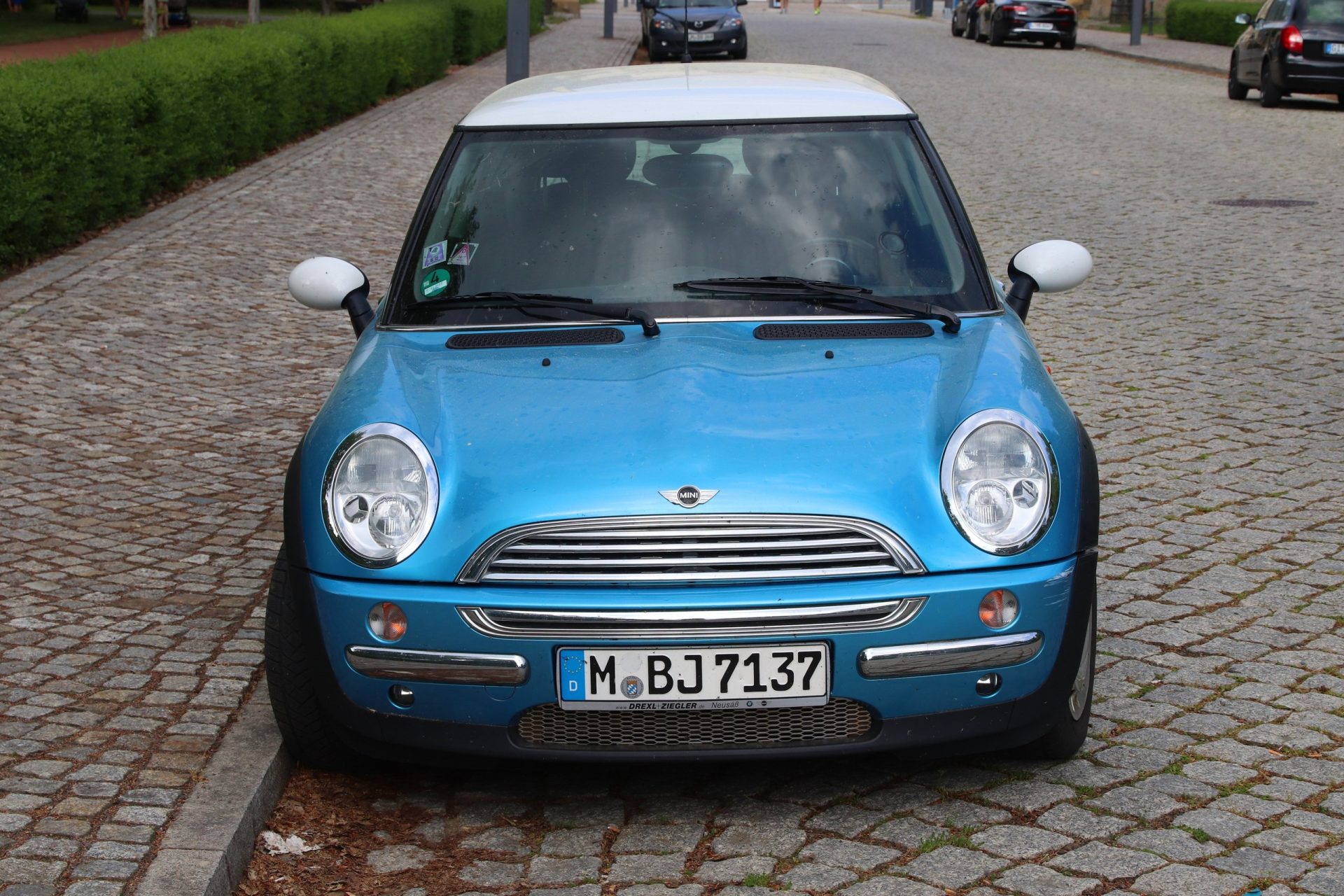
Much of the reason for adding a Mini Cooper to this worst years list is based on the FIXD Reliability Score for that particular model year. Unlike other vehicles that have an abundant frequency of sub-par scores (3 or lower), the standards are higher for the Mini Cooper. As covered earlier, most model years have a 5 or better.
This creates a minimum threshold of 5 for not getting an automatic thumbs down. At the same time, having an average or better engine reliability rating doesn’t mean a model gets assigned to the best years list by default. On the contrary, there are several reasons not to recommend some examples. Keep reading, and you’ll see how first-year status (first year of a new model or generation) and safety come into play.
Because these model years are one to avoid, I’ve bypassed the discussion about F.I.R.I.S. ratings and market values.
2007-2010 Mini Cooper

FIXD Reliability Score: 1-3/10
FIXD Internet Review Index Score (F.I.R.I.S.): 8.7-8.8/10
KBB Value: $3,242-$3,888
Fuel Economy: 27-29 mpg
RepairPal Average Annual Repairs Total: $717-$911
Safety Rating: 4.4/5
Poor FIXD Reliability Scores should be enough to convince anyone other than a Mini mechanic to run away from these model years. In particular, the 2007-2009 editions get a 1 or 2. This is also a good time to mention that 2007 is the first year of the second generation Mini Cooper. Staying away from the first year of a new edition ensures you avoid the problems that often arise with a new vehicle introduction.
My view with this group is, why spend money on a risky bet when there are so many better Mini Cooper model years to choose from? Don’t get tempted by strong safety scores, good fuel economy, and low market values.
But don’t take my word for it. Let’s examine hard numbers to convince you why a 2007-2010 Mini Cooper is best left in someone else’s driveway. The 2007-2010 editions represent 21% of the 19 model years covered by FIXD sensor engine reliability data. Yet these four years of Mini Coopers account for 60% of all recorded check engine lights.
What codes do these check engine lights include? The usual suspects involve a faulty EVAP system (P0456) or a potentially severe engine misfire (P0303). Yet it’s code P0128, a defective thermostat, that has the potential to be a significant hit to the wallet. Ordinarily, these problems just require replacing the thermostat ($220-$260) or installing a new coolant temperature sensor ($150-$200). However, the powertrain control module, which monitors the thermostat, can sometimes be the root of the problem. In this situation, expect to pay $2,049 and $2,567 for repairs. Code P0128 is very prevalent in the 2007 and 2009 model years.
I’ll add more fuel to the fire by citing the four recalls each for the 2007 and 2008 Mini Cooper. There is one official notice for the 2009 and two for the 2010 model year. Most of these recalls involve electrical issues, which don’t inspire confidence.
2014-2015 Mini Cooper
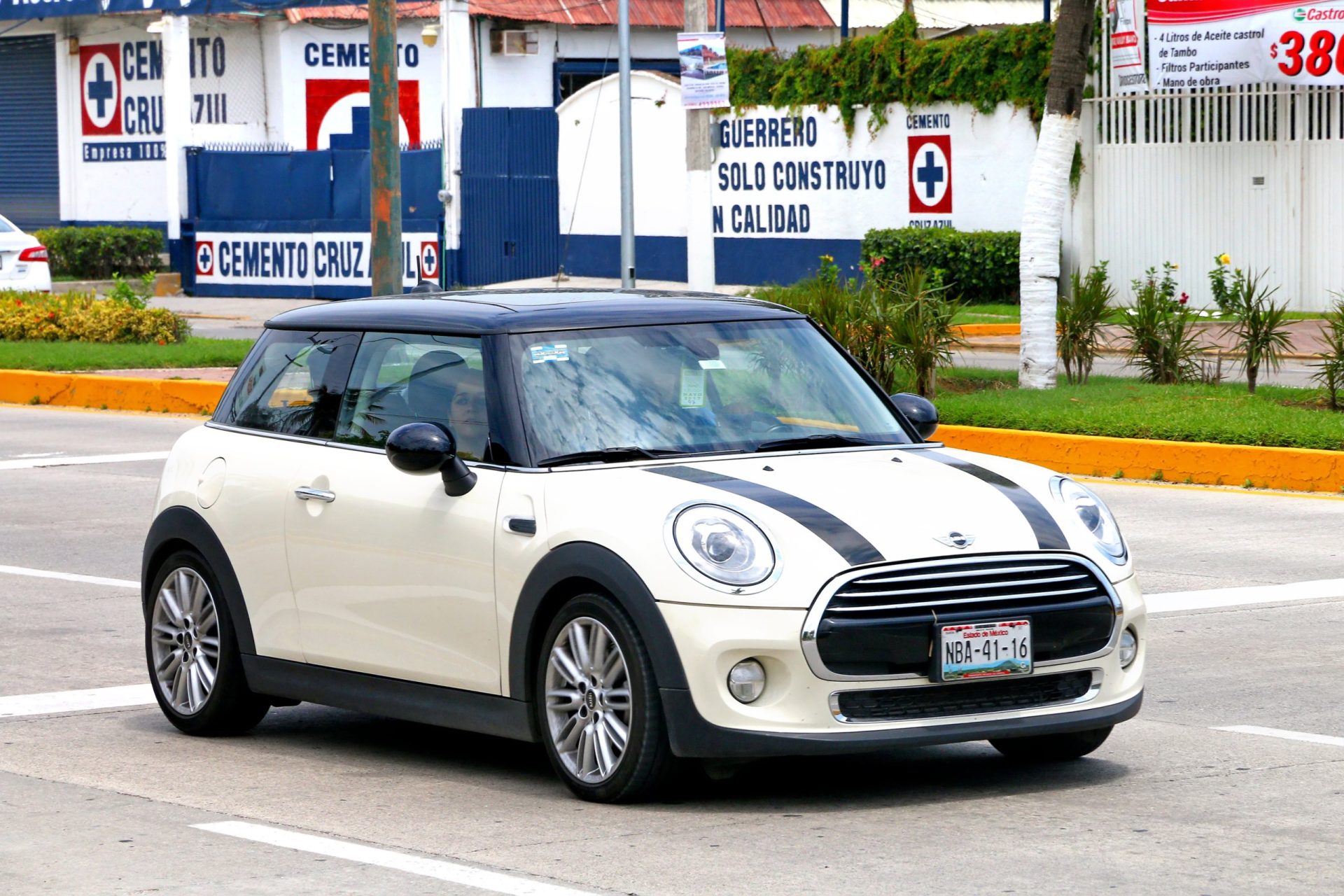
FIXD Reliability Score: 7-8/10
FIXD Internet Review Index Score (F.I.R.I.S.): 8.2-8.3/10
KBB Value: $4,652-$7,068
Fuel Economy: 29-30 mpg
RepairPal Average Annual Repairs Total: $816-$902
Safety Rating: 4.0/5
At a glance, the 2014-2015 Mini Coopers appear to be winners. A 7 or 8 FIXD Reliability Score is commendable for a ten-year-old car, as are good fuel economy and fine safety scores. Even annual repair expenses are within the average range.
So, what’s the problem with these model years besides 2014 being the first edition of the second generation? A core safety matter. NHTSA issued a “safety concern” advisory for both years, an unusual move that included a recall. The problem centers around poor crash test protection for the rear seat passengers, leading to a higher likelihood of thoracic injury. I wouldn’t want a loved one riding in this car.
What’s almost as bad is that Mini parent BMW dragged its feet in responding to the NHTSA investigation on the matter and the subsequent recall. The company was fined $10 million for its inaction.
Other safety issues involve the 2014 version being subject to seven recalls, while the 2015 edition was hit with six recalls, the most of any Mini Cooper model year. It all adds to questionable build quality and safety compliance.
These Mini Coopers aren’t free from check engine lights, either. Like other model years, the 2014-2015 model years have trouble with engine misfires (P0300, P0301, P0302, P0304) and the fuel delivery system (P087).
2002 Mini Cooper

FIXD Reliability Score: 5/10
FIXD Internet Review Index Score (F.I.R.I.S.): 9.0/10
KBB Value: $2,218
Fuel Economy: 25 mpg
RepairPal Average Annual Repairs Total: N/A
Safety Rating: 4.0/5
In truth, the 2002 Mini Cooper isn’t terrible. Its FIXD Reliability Score of 5 is a passing grade for this model. In addition, a 4.0 in NHTSA’s crash tests is a good result, and 25 MPG isn’t bad either.
Yet, this model year is the first Mini Cooper ever sold in the U.S. The risk of lingering first-year gremlins is still present after 22 years. Why take a chance when, for not much more money, you can buy a 2003-2006 Mini Cooper?
Diagnostic trouble codes common to the 2002 Mini Cooper offer additional insight. P1125 (a faulty throttle position sensor—the gas pedal and throttle aren’t communicating) and P1229 (another throttle-related issue) are more likely to occur with the 2002 model year than other first-generation years. This hints at elevated problem levels compared to more recent Mini Coopers.
There are five recalls for the 2002 Mini Cooper, more than any other first-generation model year.
FAQs
What is considered high mileage for a Mini Cooper?
There’s no official definition for what constitutes a high-mileage car. Different vehicles have different capabilities and lifespans.
A look at online for-sale listings (autotrader.com, October 31, 2023) shows 2,203 Mini Coopers for sale across the U.S. Of these, only three had at least 200,000 miles. A further analysis shows that only 3% (65) of all the Mini Coopers for sale had 150,000 miles or more. This clearly indicates that 150,000 miles is the upper limit for a Mini Cooper’s longevity. Can some examples exceed this benchmark? Certainly, but this appears to be a rarity.
Diligent maintenance and thoughtful driving go a long way in improving the maximum miles for a Mini Cooper. Regular upkeep and addressing problems at an early stage contribute to longevity. Likewise, a car that sees mostly highway use will likely stay in better condition than one that suffers through demanding stop-and-go traffic.
Given all these variables, the best determiner of a Mini Cooper’s lifespan is a professional mechanic. This technician can perform a comprehensive pre-purchase inspection to identify current issues and spot potential future troubles.
What other vehicles should I consider?
Mini offers a range of other vehicles based on the Hardtop 2 Door. The Convertible offers top-down fun for Mini fans wanting an open-air motoring experience. Meanwhile, the Hardtop 4 Door offers easier access to the back seat. At the same time, the Clubman and Countryman provide more space and all-wheel-drive capabilities.
Outside the Mini family, the Fiat 500 and 500X crossover offer the closest experience. Otherwise, you’ll need to step up to a larger but still small vehicle. Examples include the Toyota Corolla, Honda Civic, and Chevrolet Cruze.
A Note About Data and Information Sources
This article has many details about Mini Cooper reliability; here’s what we used for our assumptions and recommendations.
- FIXD Reliability Score & Data: Engine reliability information is captured via the FIXD App.
The FIXD Reliability Score is calculated using the number of DTCs per year, weighted by mileage using 12,000 per year. This is then turned into a scale of 1-10 for easy graphing.
This is an objective score.
- F.I.R.I.S & Data: This data is the result of averaging the score of the Mini Cooper from Edmunds, KBB, Cargurus, and Cars.com.
Those individual Scores come straight from reviewers and owners of the Mini Cooper.
This is a subjective score.
From here, we translate the answers into the F.I.R.I.S as all the answers are out of 5.
Keep in mind that owners may think their car is more or less reliable than it actually is.
One potential problem is that people often buy the same make or model they are used to when they go car shopping, just a newer year.
Ford, for instance, has a number of consumer loyalty awards for the Ford F-Series, Ford Mustang, and Ford Expedition.
Car owners may be so loyal to the make or model they currently own that they would have trouble accurately comparing their cars’ reliability to others.
It’s for this reason that we ask car owners a question that is relative to mileage rather than relative to other cars.
Still, be mindful of the accuracy of these F.I.R.I.S; people’s perceptions and unconscious blindspots can skew data.
We suggest looking at both the FIXD Reliability Score and the F.I.R.I.S for this reason.
- KBB Value: Average private-seller valuations as supplied by Kelley Blue Book (KBB), based on a Mini Cooper with typical mileage for that respective model year.
- Fuel Economy: Mileage-per-gallon estimates according to the EPA MPG on Fueleconomy.gov
- Annual Maintenance/Repair: Upkeep expenses as reported by RepairPal
- Safety Rating: Crash test data collected and reported by NHTSA. We average all ratings for each year to come up with a simplified, average safety score. This makes it easier to look at on a graph.
References
- Mini Cooper model-specific information, edmunds.com (various dates). Retrieved October 31, 2023, from https://www.edmunds.com/
- Model-specific recall information as per the National Highway Transportation Safety Administration. Retrieved October 31, 2023, from https://www.nhtsa.gov/recalls
- Mini Certified Pre-Owned Program Information. Retrieved October 31, 2023, from https://www.miniusa.com/model/mini-certified-preowned.html

Dave Goldberg is an automotive journalist and lifelong car fanatic. He writes for numerous enthusiast and business outlets and is an ongoing contributor to HotCars.com, one of the most popular car culture websites. When he’s not writing or driving, Dave is either under a hood or asleep. His credentials include a BA in Journalism from The George Washington University.

